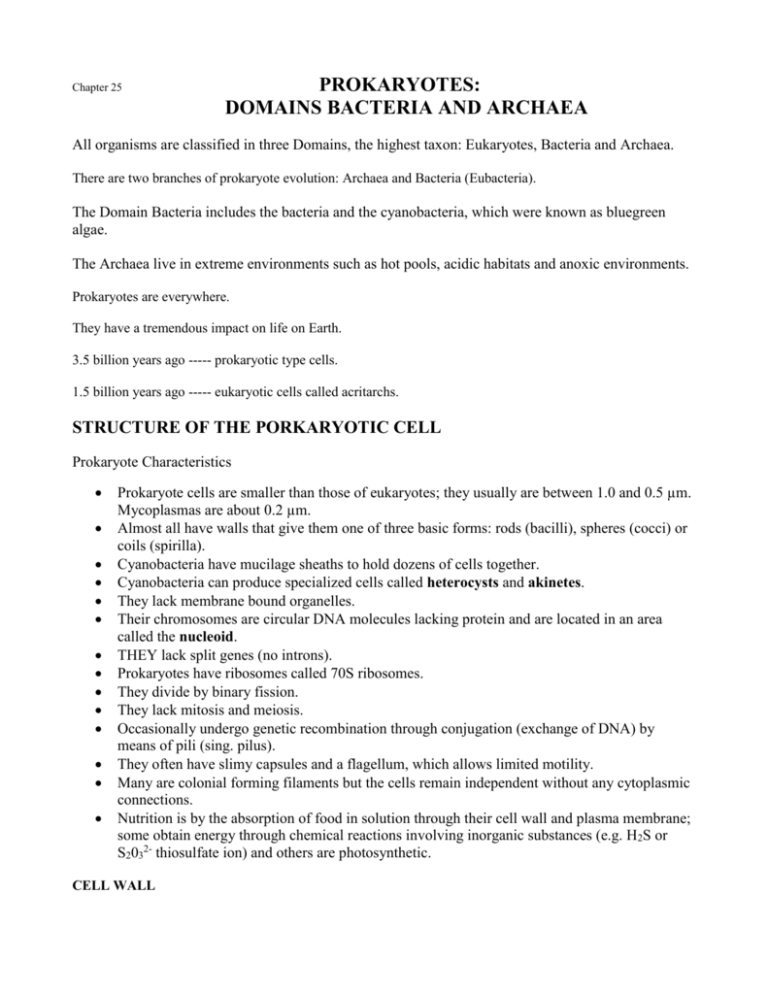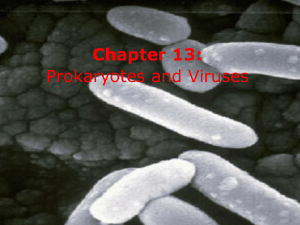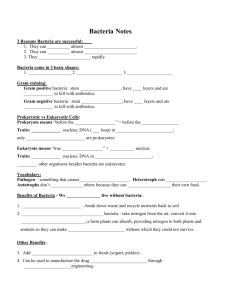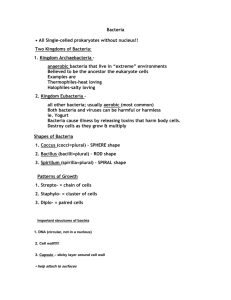Chapter 25 Prokaryotes: Domain Bacteria And Domain
advertisement

Chapter 25 PROKARYOTES: DOMAINS BACTERIA AND ARCHAEA All organisms are classified in three Domains, the highest taxon: Eukaryotes, Bacteria and Archaea. There are two branches of prokaryote evolution: Archaea and Bacteria (Eubacteria). The Domain Bacteria includes the bacteria and the cyanobacteria, which were known as bluegreen algae. The Archaea live in extreme environments such as hot pools, acidic habitats and anoxic environments. Prokaryotes are everywhere. They have a tremendous impact on life on Earth. 3.5 billion years ago ----- prokaryotic type cells. 1.5 billion years ago ----- eukaryotic cells called acritarchs. STRUCTURE OF THE PORKARYOTIC CELL Prokaryote Characteristics Prokaryote cells are smaller than those of eukaryotes; they usually are between 1.0 and 0.5 µm. Mycoplasmas are about 0.2 µm. Almost all have walls that give them one of three basic forms: rods (bacilli), spheres (cocci) or coils (spirilla). Cyanobacteria have mucilage sheaths to hold dozens of cells together. Cyanobacteria can produce specialized cells called heterocysts and akinetes. They lack membrane bound organelles. Their chromosomes are circular DNA molecules lacking protein and are located in an area called the nucleoid. THEY lack split genes (no introns). Prokaryotes have ribosomes called 70S ribosomes. They divide by binary fission. They lack mitosis and meiosis. Occasionally undergo genetic recombination through conjugation (exchange of DNA) by means of pili (sing. pilus). They often have slimy capsules and a flagellum, which allows limited motility. Many are colonial forming filaments but the cells remain independent without any cytoplasmic connections. Nutrition is by the absorption of food in solution through their cell wall and plasma membrane; some obtain energy through chemical reactions involving inorganic substances (e.g. H2S or S2032- thiosulfate ion) and others are photosynthetic. CELL WALL Eubacteria: peptidoglycan with muramic acid cell wall. Gram-positive cells Thick wall, 15 – 80nmlayer of peptidoglycan. Peptidoglycan is a polysaccharide made of N-acetylgucosamine and N-acetylmuramic acid. The molecules peptide bridges form crosslinks and the wall becomes one giant molecule. For more details about the structure of the gram-positive cell wall see: http://student.ccbcmd.edu/courses/bio141/lecguide/unit1/prostruct/cw.html Gram-negative cells The peptidoglycan layer is thin, about 10nm. A layer of lipopolysaccharide (LPS) covers the peptidoglycan layer. The LPS does not contribute to the strength of the wall but is semipermeable in nature and prevents large proteins from approaching the cell membrane. LPS is extremely toxic to animals. For more details about the structure of the gram-negative cell wall see: http://student.ccbcmd.edu/courses/bio141/lecguide/unit1/prostruct/gncw.html Archaebacteria: cell wall incorporates other substances but no muramic acid. FLAGELLA Many bacteria have flagella Cyanobacteria and archaeans lack flagella. The flagellum is hollow and is anchored to the cell by a set of rings. One ring is attached in or near the cell membrane and the other in the peptidoglycan layer. In gram-negative bacteria, a third set of rings lies near the LPS layer. Flagella are located at one or both ends of the cell (polar flagellation) or over the entire surface (peritrichous flagellation). They rotate continuously and permit the bacterium to swim rapidly. Motile bacteria appear to sense certain stimuli and swim toward or away from them. CELL DIVISION AND REPRODUCTION This circular DNA molecule is usually attached at one point to the plasma membrane. The bacterial DNA is sometimes called the genophore. The chromosome of bacteria contains about 1/1000 of the DNA material found in eukaryotes, and has relatively little protein associated with it. Replication and translation is similar to eukaryotes. Plasmids are small circular DNA molecules found in bacteria. Plasmids are separate and independent from the chromosome Plasmids are capable of replication. Plasmids have small number of genes. These genes are not normally needed for reproduction or survival of the bacterium. These often encode antibiotic resistance genes, and genes encoding unusual metabolisms. Plasmids often consist of copies of one or at most very few different plasmids. Plasmids can be transferred between cells by conjugation. CELL DIVISION Bacteria are haploid and they lack meiosis. Their reproduction is by binary fission. DNA replicates and a transverse wall is formed by the ingrowth of the plasma membrane and cell wall. A bacterium may have several circular chromosomes before the cell divides. EXCHANGE OF GENETIC MATERIAL Transformation: When a bacterium dies and falls apart, its DNA breaks into short chains containing a few genes; other bacteria cells absorb these small pieces and some may be inserted into the cell’s DNA thus becoming part of the cell genome. The foreign genes can now be passed to daughter cells. Transduction: a virus invades the bacterium and reproduces. Small pieces of the bacterium DNA can be incorporated into the virus. When a virus attacks a new bacterium, the DNA from the first bacterium is released and then is incorporated into the DNA of the second bacterium. Bacterium enzymes usually destroy the foreign DNA though. Conjugation: It occurs when two cells of different mating types come together and genetic material is transferred from one cell to the other by means of a sex pilus. The pilus is made of proteins. Genetic exchange has never been found in cyanobacteria. METABOLISM Prokaryotes have alternate methods for many metabolic processes like photosynthesis, cellular respiration and sources of energy. Many bacteria utilizing a few simple sugars and essential minerals synthesize all their own vitamins, lipids, amino acids and other macromolecules. In many plant cells, many amino acids and lipids are synthesized in plastids, which are prokaryote-derived organelles, and not in the cytosol. PHOTOSYNTHESIS See Mauseth pages 240 and 241. Cyanobacteria produce carbohydrates using the C3, Calvin Cycle, of photosynthesis. This process is the same as the one used by land plants. This similarity is not surprising because chloroplasts in all probability arose from the endosymbiosis of cyanobacteria. Cyanobacteria have chlorophyll a as the photosynthetic pigment but lack chlorophyll b. Accessory pigments are phycobilin, which absorbs light most strongly between 620 and 640 nm, yellow zone of the spectrum. And phycoerythrin, with maximum absorption of light at 550 nm, blue zone of the spectrum. They posses a PS I and PS II (photosystems). Oxygen is a byproduct of photosynthesis, oxygenic photosynthesis. Purple and green bacteria do not have chlorophyll a, but instead have bacteriochlorophylls. Bacteriochlorophylls are made of tetrapyrroles similar to chlorophyll but differ in some of the side chains and functional groups. There are carotenoids present that act as accessory pigments. There is only a PS I present; PS II is absent and electrons cannot be put back onto the bacteriochlorophyll. The original electron comes back through a series of carriers, so the electron flow is cyclic. Quinone carriers pump electrons from the cytoplasm into the periplasm creating an electrochemical gradient that is used to generated ATP. This is a chemiosmotic process. No oxygen is formed, anoxygenic photosynthesis. Bacterial photosynthesis is a proton pumping process. NITROGEN FIXATION Nitrogen is an essential element for the making of proteins. Atmospheric nitrogen is mostly inert and cannot be used directly by most organisms. Plants take it the form of ammonia and nitrate. Nitrogen in organic compounds of dead animals and plants is unavailable to plants and must transformed by decomposers into inorganic compounds. Proteins found in dead plant and animals are broken down by bacteria and fungi, and oxidized to CO2, H2O and NH3 with yield of energy. Examples: RNH2 (Organic N) + heterotrophic (ammonifying) bacteria → NH3 (ammonia) + R (organic molecules). NH2CH2COOH + 1½ O2 → 2CO2 + H2O + NH3 + 178 kcal In soils NH3 is rapidly converted to NH4+ when hydrogen ions are plentiful (pH < 7.5). NH3 and NH4+ are absorbed by plant roots and incorporate into amino acids and passed through the food chain. Nitrification: During nitrification NH4+ is oxidized to nitrate (NO31-) and nitrite (NO21-). Nitrosomas bacteria use ammonia as their sole source of energy. NH4+ + O2 → HNO2 + 1½ H2 → NO21- + 4H+ + 165 kcal Nitrobacter uses the energy left in nitrite by oxidizing it to nitrate. NO21- + 1½ O2 → NO31- + energy. Nitrosomas oxidizes 35 moles of nitrogen for each mole of CO2 assimilated; Nitrobacter oxidizes 100 moles of nitrogen for every mole of CO2 assimilated. Nitrates are absorbed by plants and incorporated into organic acids. Most plant species prefer nitrate to ammonium. Nitrates leach more readily than ammonium and eventually may end in aquatic ecosystems. SULFUR BACTERIA Sulfur is rarely a limiting nutrient in the environment and is usually absorbed as SO4-2 . Sulfate is absorbed by plants and incorporated into sulfur containing amino acids, which are passed down the food chain. Decomposition of organisms releases sulfate and hydrogen sulfide Sulfate-reducing bacteria release sulfur found in dead organic matter as H2S and SO4-2. Purple bacteria found in salt marshes and estuarine mudflats utilize SH2 as an oxygen acceptor to reduce CO2 . 6 CO2 + 3 H2S + 6 H2O + sunlight C6H12O6 + 3 H2SO4 H+ + SO4-2 CLASSIFICATION OF PROKARYOTES Because prokaryotes are mostly unicellular and lack a variety of anatomical and morphological traits, their classification has been based mostly on their metabolism, wall chemistry, their ability to carry on photosynthesis, and sensitivity to oxygen. Nucleotide sequencing is now the most reliable technique used in phylogenetic analysis. 16S ribosomal RNA is the most commonly sequenced nucleic acid. Ribosomes are present in all living organisms. Ribosomal gene mutations appear to be almost always lethal. Therefore, 16S rRNA is extremely conservative and evolves very slowly. Large portions of 16S rRNA are identical in organisms that diverged long time ago. DOMAIN ARCHAEA The archaeans are distinct metabolically but their structure is very similar to that of other prokaryotes. Archaeans lack membrane bound organelles. They have a 70S ribosome type. They have cell wall. They differ from bacteria in: Their walls have protein, glycoproteins or polysaccharide, but lack true peptidoglycan and therefore, they are immune to most antibiotics that interfere with bacteria wall synthesis. Membranes with unusual lipids that have their fatty acids attached to glycerol with ether linkages rather than ester linkages. Some lipids are diglycerols, in which each end of the fatty acid is linked to a glycerol. Archaea live in extreme environments like salt pools, sulfur-rich hot acid pools, and anaerobic H2S-rich environments like sewage treatment plants. DOMAIN BACTERIA Bacteria have a much greater diversity of metabolic pathways than do the archaeans. The following groups are probably polyphyletic. Gliding bacteria Gliding bacteria lack flagella, and move only when in contact with a solid surface. Some consists of long filaments of short disk-like cells. Baggiatoa oxidizes H2S first to S0 then to SO42-. It forms mutualistic associations with cattails, rice and plants that live in stagnant water; it receives nutrients from the plant while protecting its roots for H2S. Cytophaga digests cellulose and chitin. Cellulases are part of the cell envelope and are not released. They are important in humus formation and soil ecology. Nitrogen metabolizing bacteria Nitrogen-fixing bacteria convert atmospheric nitrogen (N2) to nitrites (NO21-), nitrates (NO31- ) and ammonia (NH3). Nitrifying bacteria convert NH3 to NO21- and NO31-. Denitrifying bacteria convert nitrates in the soil to atmospheric nitrogen, N2. In natural ecosystems, about 1200 species of bacteria, cyanobacteria and legumes are involved in nitrogen fixation. Rhizobium is the bacterium genus associated with legumes. Rhizobium is aerobic. Azotobacter and Clostridium are free-living aerobic genera found in the soil. These three genera require Mo as an activator. All these species are inhibited by the accumulation of nitrates and ammonia in the soil. About 40 known species of cyanobacteria are important nitrogen fixers. They are found in terrestrial and aquatic habitats and require Mo for nitrogen fixation. They are active over a wide range of temperatures, from polar seas to freshwater ponds to hot springs. Other plants are also involved in nitrogen fixation: some epiphytes in tropical forests, epiphyllic algae and bacteria, and phycobiont algae in lichens. Mycoplasmas Mycoplasmas are the smallest living cells know: 0.2 – 0.3 µm. They lack cell wall. Variable shape: filamentous, coccoid, and rod-shaped. Many are pathogenic to plants and animals. Cyanobacteria Cyanobacteria vary in size from cells of the size of typical bacteria to the largest cell of prokaryotes, Oscillatory princeps, which is 60 µm in diameter. Some are unicellular but the majority exists in large groups held together by mucilage, or attached to surfaces forming long filaments. Their cell wall is similar of that of gram-negative bacteria and produce mucilage. Cyanobacteria seem to be the most closely related to the organisms that gave rise to the chloroplasts of eukaryotes. They all have chlorophyll a and PS II, and produce oxygen. Prochlorophytes are a group of cyanobacteria that have both chlorophyll a and chlorophyll b, and lack phycolbilins. Many are nitrogen fixing, a process that takes place in heterocysts. If there is NH4+ in the environment, heterocysts do not develop, but if it is lacking, heterocysts develop from vegetative cells. They may form akinetes, large thick wall cells derived from vegetative cells and used to survive periods of harsh environment. Most species are free living, but some form mutualistic relationships with plants: Anabaena and Azolla and cycad roots; Nostoc and Anthoceros. Some can withstand very harsh periods of environmental change,, like extreme desiccation or very hot pools. In hot pools, they extract lime from water and form rock-like masses. They form stromatolites in warm waters. Stromatolites are large column like structures of bacteria encrusted with CaCO3. The most ancient stromatolites are thought to be 3.2 billion years old. Cyanobacteria grow in both salt and fresh water and are capable of forming large blooms when the conditions are good.









